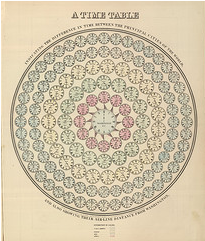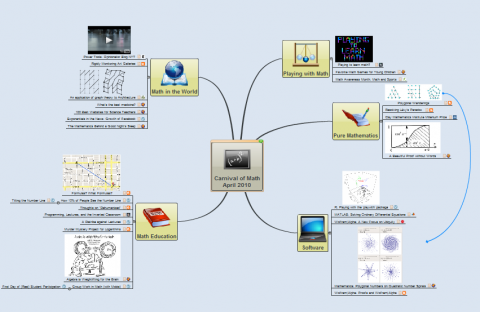Archive for the ‘Carnival of Math’ Category
Welcome to the very late 76th carnival of Maths. As per tradition, lets start with the trivia. 76 is an automorphic number , can be written as a sum of three squares (2^2+6^2+6^2) and is the 9th Lucas number.

Every now and then I get asked the question ‘Eigenvectors….so what are they good for?’ I’ve got a few stock answers but Language Log’s Mark Liberman goes the extra mile when he considers how they might have been used in Cinderella and goes on to discuss how they are used in linguistics. Are you suitably intrigued? Check it out in Eigenfeet, eigenfaces, eigenlinguistics, …
If you have worked on the classification of multivariate data then you may well have heard of or used the Mahalanobis distance (I came across it for the first time when working with MATLAB’s pdist function). It turns out that this commonly used metric has rather surprising origins! Read all about it in Anthropometry and Anglo-Indians over at Jost a Mon.
March 14th is, of course, Pi day and several bloggers have written something about everyone’s favouburite irrational number. Carnival regular, John D. Cook, brings us A Ramanujan series for calculating pi, 360 has The Difference and Qiaochu Yuan counters with Pi is still wrong. Finally, madkane brings us a Pi day limerick.
Over at God Plays Dice, Michael Lugo brings us A street-fighting approach to the variance of a hypergeometric random variable and some of Denise’s favourite math websites have gone AWOL over at Let’s Play Math. Can you help her find them?
Peter Rowlett asked Twitter for links to enthuse people about mathematics. Here are the answers. Finally, Guillermo Bautista gives us an example of the epsilon-delta definition of limits.
Your Carnival needs you
The Carnival of Math desperately needs people to write and host future editions. If you have a math related blog and would like a bucket-load of extra traffic then contact me for more information.
Welcome to the slightly delayed Carnival of Mathematics #74 – Tungsten Edition. In a departure from COM tradition, this edition is on the same blog as the last edition due to a lack of hosting volunteers. Fortunately, however, the volunteers are starting to turn up and so this is the last month that you’ll have to put up with me for a while. Next month will see the carnival hosted by Daniel over at General Musings and April will be taken care of by AcmeScience (thanks peeps!). The rest of the year is up for grabs so if you’d like to host a future carnival then contact me and we’ll work something out.
One tradition that I’m not about to give up on, however, is the number trivia section. So, let’s see what 74 has for us. In stark contrast to 73, the Chuck Norris of Numbers, 74 doesn’t seem to have much going for it. It’s probably overweight for a start since it is the 3rd hungry number (hungry because it tries to eat as much Pi as possible). Other than that it is odious, semiprime and altogether rather dull!
Enough of the trivia and on with the show.
First up we have a post from Datavisualization.ch which shows a set of infographics from around 150 years ago. Much of this work is rather beautiful and demonstrates that the field of infographics is much older than you might think.
 For a rather more modern take on statistics and infographics I highly recommend the UK BBC Four TV documentary, The Joy of Stats. This was a one off show broadcast in late 2010 and hosted by Hans Rosling (Also the star of a brilliant TED talk). Several clips of the show are available over at The Open University and it was recently mentioned by The Royal Statistical Society.
For a rather more modern take on statistics and infographics I highly recommend the UK BBC Four TV documentary, The Joy of Stats. This was a one off show broadcast in late 2010 and hosted by Hans Rosling (Also the star of a brilliant TED talk). Several clips of the show are available over at The Open University and it was recently mentioned by The Royal Statistical Society.
From statistics and onto the theory of numbers with a post by Matt Springer called ‘Sunday Function’. In this post, Matt demonstrates a wonderfully simple proof concerning fractions which have terminating decimal expansions. It turns out that it just happened to be a Sunday morning when I read this delightful little post over coffee and it set me up for the day.
Number theory has been big news in the mathematical world recently thanks to some work by Ken Ono and colleagues who have found a finite, algebraic formula for partition numbers. The original papers can be found at http://www.aimath.org/news/partition/ (thanks to everyone on twitter who sent me that) and there has been discussion all over the web including at Wired.com and The Language of Bad Physics. Emory University (where Ken works) have a press-release but the best resource I’ve found so far is an informal talk by the man himself at YouTube (see below).
One of my biggest personal interests is mathematical software and so my contribution to this month’s carnival is a round-up of mathematical software news for January. January also saw a post from Wolfram Research on how to use some of Mathematica’s new control theory functions to stabilize an inverted pendulum which also serves as a nice introduction to some standard control theory techniques.
Another mathematical software article that was brought to my attention last month was a post from the Mathcad team concerning a very simple looking integral. Computers often do symbolic calculus using different techniques to human beings and this is occasionally reflected in the results. Check out the article for the details.
On a lighter note, we have Music is Math: Ten Songs about Mathematics from Dave Richeson of ‘Division by Zero’ fame. My favourite of the bunch is ‘A finite simple Group of Order 2’ (below) which I’ve some across before. The rest of them, however, are new to me and a lot of fun (and in a couple of cases, quite nice to listen to).
My boss used to be a research mathematician and is something of a pedant (In a good way Chris…in a good way). It seems that this is a trait he has in common with Peter Rowlett, author of Travels in a mathematical world, who has written a piece called Pedantry on Euler and Masts where he investigates the facts behind an old Euler story. There’s also some interesting discussion of the difficulty of presenting maths for the masses.
Whereas I do Random Walking, Sander Huisman does Random Hopping and in the process he comes up with some great looking pictures and interesting mathematics.
John D. Cook compares the iPhone to the method of least squares in When it works, it works really well, Ed4All shows us a mental arithmetic short cut for squares ending in five and Math-Frolic presents A Seemingly Impossible Task, That Isn’t.
Last but by no means least, Guillermo Bautista, organiser of the Math and Multimedia blog carnival, gives us an introduction to similarity while Alasdair’s Musings brings us A cute result relating to sums of cubes.
- Follow the Carnival of Math on Twitter: @Carnivalofmath
- Learn more about Math Carnivals: What is a math carnival?
73 is an awesome number. In fact, one could argue that it’s the Chuck Norris of numbers. Here’s why (courtesy of Wikipedia, and Number Gossip):
- The mirror of 73, the 21st prime number, 37, is the 12th prime number. The number 21 has factors 7 and 3.
- In binary, 73 is a palindrome – 1001001
- Of the 7 binary digits representing 73, there are 3 ones.
- Every positive integer is the sum of at most 73 sixth powers.
- In octal, 73 is a repdigit – 111
- Pi Day occurs on the 73rd day of the year (March 14) on non-leap years
- 73 is the largest integer with the property that all permutations of all its substrings are primes
- 73 is the largest two-digit Unholey prime: such primes do not have holes in their digits
- 73 is the smallest number (besides 1) which is one less than twice its reverse
- 73 is the alphanumeric value of the word NUMBER: 14 + 21 + 13 + 2 + 5 + 18 = 73
73 is also the edition number of this, the latest Carnival of Mathematics, to which I bid you welcome. On with the show.
First up we have a mathematical calendar for 2011 courtesy of Ron Doerfler which focuses on Lightning Calculations. I have written about Ron’s calendar before and highly recommend it to all.
The beginning of a new calendar year is an opportunity for all of us to sit back and take stock of everything that took place over the previous 12 months. As a result you’ll find retrospectives of all kinds scattered around the internet and on TV such as The Best Tech Products of 2010, TV’s 11 best Watercooler Moments of the Year and so on. Over at his blog, Wild About Math, Sol Lederman points us to a much more mathematical restrospective of the year 2010 by giving us a heads up about an awesome looking new book.
Next we have the 2011 Mathematics game from Denise of Let’s Play Math; the rules of which can be most simply stated as “Use the digits in the year 2011 to write mathematical expressions for the counting numbers 1 through 100.” Head over there to see more detailed rules, hints, tips, discussion and solutions found so far.
If all of that isn’t quite enough to sate your appetite for all things 2011 then I suggest that you take a look at Patrick Vennebush’s post entitled 2011 – Prime Time which inspired Brent Yorgey to follow up with Prime Time in Haskell. I wonder if 2012 will inspire such mathematical and computational outpourings?
In her post, Two Planes, Tanya Khovanova stumbled across a seemingly innocent looking question in an old edition of Mathematics Teacher which made her take a deep breath and exclaim ‘Ooh, boy!’. Check it out to see what all the fuss is about.
In Redefining Great Britain, GrrlScientist highlights some new research that describes a clever way to redefine and redraw geographical areas using telephone communication networks — it relies on statistics and computing power.
Sander Huisman has a crack at inventing his own fractal based upon the q-gamma function using Mathematica and a heap of computer time. The resulting fractal zoom looks great. He’s also produced a really neat animation of a hinged tesselation.

How do you abbreviate the word ‘Mathematics’? Some say ‘math’ others say ‘maths’ but which came first and which is the most popular? In his post, Math/Maths in Google Books Ngrams, Peter Rowlett uses Google Ngrams to sample millions of books in order to try and determine the answer to these and similar questions.
The trapezoidal rule for numerical integration has been in the news recently and so John Cook of The Endeavour shows us Three surprises with the trapezoid rule.
Imagine that we want to bet on an event with m >= 2 possible outcomes, and that there are n >= 2 bookmakers taking bets on those outcomes. Note that the odds are known at the time the bets are placed, i.e., we have fixed-odds betting instead of pari-mutuel betting. We would like to know how to allocate our (limited) money, i.e., how much to bet on each outcome at each bookmaker. As we cannot foresee the future, we would very much like to lock in risk-less profits. In other words, we would like to find arbitrage opportunities (aka: “arbs”). In his post, Fixed-Odds Betting Arbitrage, Rod Carvalho discusses how, given the (fixed) odds posted by n bookmakers, we can detect the existence of arbitrage opportunities.
PhD student, Gianluigi Filippelli, considers a problem from way back in the 13th century in his post Fibonacci, Bombelli and imaginary numbers. Personally, I’ve always loved some of the historical aspects of mathematics and hope to attend a good course on it some day.
Finally, we have a post from Guillermo Bautista called Chess and the Axiomatic Systems where he provides an intuitive introduction to the notion of axiomatic systems through chess rules.
That’s it for this time but if you still need more mathematical blogging then check out The 12 Math Carnivals of 2010 and don’t forget to submit your articles to the forthcoming Math Teachers at Play carnival.
Follow the Carnival of Math on Twitter: @Carnivalofmath
2010 was a great year for mathematical blogging and this was reflected in the monthly Carnivals of Mathematics. Here they are again in case you missed them.
- January – 61st Carnival at Walkingrandomly
- February – 62nd Carnvial at The Endeavour
- March – 63rd Carnival at Mathrecreation
- April – 64th Carnival at Teaching College Math
- May – 65th Carnival at Maxwell’s Demon
- June – 66th Carnival at Wild About Math
- July – 67th Carnival at Travels in a Mathematical World
- August – 68th Carnival at Plus Magazine
- September – 69th Carnival at JD2718
- October – 70th Carnival at General Musings
- November – 71st Carnival at Theorem of the Day
- December – 72nd Carnival at 360
The cycle will be starting again next week when the 73rd carnival gets published right here at Walking Randomly. What happens after that is up to you because I need volunteers to host future editions. If you are interested then get in touch via the comments section of this post, via twitter or by email.
Links
- What is a maths carnival?
- Math Carnival submission form
- Math Teachers at Play – The sister carnival to CoM
The 64th Carnival of mathematics has been posted over at Maria’s Teaching College Math blog and it is rather different from the norm. Posted as a mind map, it includes articles on a Murder Mystery project for logarithms, weightlifting for the brain, MATLAB, R, the mathematics behind a good night’s sleep and much more.
If you are new to math carnivals and are wondering what is going on then check out my introductory post here.
Other recent carnivals include:
- Math Teachers at Play #24 – posted at Let’s play Math
- Carnival of maths #63 – posted at Mathrecreation
- Math Teachers at Play #23 – posted at Mathrecreation
- Carnival of maths #62 – posted at The Endeavour
There are two carnivals in the mathematics blogging world: The Carnival of Maths (CoM) and Math Teachers at Play (MTAP), which are basically two different facets of the same thing — but exactly what are they?
At the most basic level, a maths carnival is just a set of links to recent blog articles about mathematics, but that’s selling the whole idea short somewhat. I’ve always liked to think that the two carnivals are the shop-front of the mathematics blogging world — a reason for us all to get together and celebrate everything that we are proud of in our little corner of the web. Other people compare a blog carnival to a magazine’s table of contents, which can direct you to a wide variety of articles. The articles are written by different people, but they are all tied together by the theme/focus/area-of-interest that defines the magazine.
The best way of demonstrating what the carnivals are all about is to show you some examples, so here are the two most recent editions (I’ll try to keep this updated):
- Carnival of Mathematics #77 – Jost a mon
- Math Teachers at Play #37 – Math Insider
Let’s look at how the carnivals work in more detail.
Say you have just written a recent mathematical blog post which you are rather proud of. Obviously you’d like as many people as possible to read your article, so you choose one of the two carnivals and submit it using one of the two forms below:
- Carnival of Mathematics submission form (Any kind of maths at any level)
- Math teachers at play submission form (Any kind of maths from preK-12 — which is pretty much all mathematics taught to 19 year olds and below)
The carnivial host will receive your submission and, if they think it is suitable, will include it in their carnival. You can then sit back and watch the extra traffic roll in.
Here are some frequently asked questions about both carnivals.
When are the carnivals published?
The Carnival of Maths usually gets published on the first Friday of the month and Math Teachers at Play gets published on the third Friday.
I would like to host a carnival at my blog. What should I do?
Go to the relevant carnival home page and click on ‘Future Hosts’. This will show you who is scheduled to host for the next few months. Find an empty slot that suits you, contact me for the CoM or Denise for MTAP, and we’ll take it from there.
Who does the admin for the Carnivals?
At the moment, I am doing the admin for the Carnival of Math, and Denise of Let’s Play Math is looking after Math Teachers at Play. So, if you have any questions, then we are your first port of call.
I’ve found a cool maths article that someone else has written. Can I submit it to the carnivals?
Yes, but in an ideal world it will be a recent post and should have never been submitted to one of the carnivals before. The best way to be sure of this, if the post is not your own, is to send in only something published since the last edition of the carnival.
Can I submit an article to both carnivals?
We’d rather you didn’t — at least, not the *same* article. We don’t want to bore the audience.
Who decides what gets included in a carnival and what doesn’t.
The carnival hosts. The carnival is just a guest on the host’s blog, and so what each host writes is entirely up to him or her. In general, most carnival hosts will include almost everything that is submitted to them and a bit more besides. However, if they choose NOT to link to something, then so be it.
The blog carnival server has been known to lose submissions on occasion. I have not heard of trouble with the maths carnivals, but the (much larger) Carnival of Education used to have problems quite often. If you are sure that your article met the carnival guidelines, but the host did not include it, then perhaps it simply got lost. Feel free to resubmit your post for the next edition.
Do I have to be a math teacher to submit an article to Math Teachers at Play?
No. As long as the mathematics is below college-level, then you are good to go
Will the Carnival of Math take articles on basic math?
Yes — everything from kindergaten to cutting edge research is fair game for the Carnival of Math. Basic mathematics can be submitted to either carnival, but advanced maths should generally be submitted only to the Carnival of Math.
Do you accept articles from subjects such as computer science or physics?
As long as there is a reasonable amount of maths content, then yes.
Is there anything else I need to do, besides submitting my article?
No, there is nothing else you have to do. When the carnival is published, however, you may want to post a link to it on your blog. The carnival host will appreciate your support, and your readers will enjoy a chance to browse what other math bloggers have written.
Does the carnival have a twitter feed?
Yes, @Carnivalofmath
Today is a big day! Not only is it the first day of the new year but it’s also the first day of a new decade! In addition to all of that it is also time for the 61st Carnival of Mathematics and this one has shaped up to be a great one thanks to the growing army of carnival contributors out there. So, put off joining the gym for one more day; Sit back, relax and enjoy this feast of pulchritudinous mathematics.
First off, as per long standing carnival tradition, let’s look at some interesting properties of the number 61. Well, it’s prime for a start but so are a lot of numbers so maybe that isn’t so interesting. However, 61 is the smallest multidigit prime p such that the sum of digits of p^p is a square (pop-quiz – what is the next one?). While on the subject of primes, 61 is the smallest prime who’s digit reversal is square! It also turns out that the 61st Fibonacci number (2504730781961) is the smallest Fibonacci number which contains all the digits from 0 to 9. (Thanks to Number Gossip for these by the way).
So 61 is a lot more interesting than you thought huh? If it had a name then it would be Keith and he would be Australian.

Puzzles, games and problems.
Let’s kick things off with a few puzzles. Sam Shah has submitted a problem for you to try which was originally created by his sister (A physics teacher) in A stubborn equilateral triangle.
If you are in the market for some online math games and lessons then head over to TutorFi.com and see what Meaghan Montrose has found for you.
Jonathan has a very interesting puzzle over at his blog, jd2718, called Who Am I (Teacher Edition) which should keep you thinking while you recover from the new year festivities.
Finally, Erich Friedman has prepared a set of holiday puzzles for 2009 for you all to try.
Explorations, discussions and messing about with maths
Pi is irrational right? Have you ever seen the proof? If not then you need to check out Brent Yorgey’s three part series on the irrationality of Pi over at The Math Less Travelled. Part 3 of this series forms Brent’s submission to today’s carnival.
Pat Ballew has had his math class working on some maximization problems recently and his article Exploring an Isoperimetric Theme discusses a discovery about a “rule of thumb” for some maximization problems. In a later post he wonders if there is a relation between the shape of a polygon and the maxium length of the diagonals (for a fixed perimeter).
Something that has kept potamologists awake over the years is the geometry of meandering rivers. If you’ve ever wondered about the same thing then head over to Division by Zero to see what Dave Richeson has to say on the subject.
Terry Tao has been getting into the holiday season with a ‘more frivolous post than usual’ in A demonstration of the non-commutativity of the English language while Qiaochu Yuan of Annoying Precision gets more serious and considers the combinatorics of words in The cyclotomic identity and Lyndon words.
Matters of a statistical nature
John D. Cook has been contemplating questions involving rare diseases and counterfeit coins over at The Endeavour.
Over at An Ergodic Walk the author has been discussing a statistical problem of how to estimate a probability distribution from samples when you don’t know e.g. how many possible values there are. An example application is estimating the number of different butterfly species from a sample containing many unique species.
I don’t know about you but I like to have a game of cards with my mates from time to time (Poker is our usual game of choice and I am fantastically bad at it). Every now and then a small ‘discussion’ breaks out concerning how shuffled the deck of cards is which is usually solved by somone reshuffling them ‘properly’. But how many suffles are necessary to randomize a deck of cards? Mathematically, card-shuffling can be viewed as a random walk on a finite group and, thus, it can be modeled by a Markov chain. Rod Carvalho has the details.
Techno Techno Techno….the technological side of mathematics
Sage is one of the best free mathematical software packages you can get at the moment and the project is led by William Stein, an associate professor at The University of Washington. In his post Mathematical Software and Me he discusses his past experiences with mathematical software and recounts the series of events that led him to start the development of Sage. If you are interested in Sage and can program in Python and Javascript then you may want to consider my Sage Bounty Hunt.
Wolfram Alpha has been a big hit among mathematics bloggers this year and, since it was launched back in May, Wolfram Research have added a lot of new features to it. For a list of some of the more recent features check out the latest post from the Wolfram Alpha Blog – New Features in Wolfram|Alpha: Year-End Update.
Visualisation of volume data is getting easier every day thanks to products such as MATLAB and Patrick Kalita recently gave an internal talk to Mathworks engineers explaining how to do it. This talk was recorded and turned into a series of 9 blog posts by Doug Hull over at Doug’s MATLAB Video Tutorials and the final part was posted early in December.
Teaching, learning and testing
Explaining mathematics can be hard and there are many different ways of teaching it. In How We Teach, Joel Feinstein shares some of his methodologies and includes a screencast of a talk of his entitled “Using a tablet PC and screencasts when teaching mathematics.”
Every year, many hundreds of mathematics graduate students take language exams where they translate some technical writing in French,German or Russian into English. These translations are then graded and thrown away which seems like a waste of effort when you think about it. David Speyer wonders if there is a more useful way to administer language exams in his post Let’s make language exams useful.
Finally, Eric Mazur has posted a ‘video confession’ on YouTube saying “I thought I was a good teacher until I discovered my students were just memorizing information rather than learning to understand the material. Who was to blame?”
Happy new Year – Math Carnival Style!
Now that it is officially 2010 you will be in need of a new calendar which is where Ron Doerfler of Dead Reckonings comes in. He has created a great looking calendar called The Age of Graphical Computing and has made it all available for free. Just download, print and away you go. I have to confess that I am too lazy to build them myself and so only wish that he could make them available for sale somehow. What about it Ron?
So, that’s it for this edition of the carnival – I hope you enjoyed it. The next one will be published on February 4th and I am still looking for someone to host it. So, if you have blog about mathematics and would like a traffic boost then drop me a line and we’ll discuss it.
The 61st Carnival of Mathematics will be hosted here on 1st January 2010 so please head over to the carnival submissions page and help make 2010 start with a mathematical bang. For an idea of what the carnivals look like check out the 60th over at SumIdiots blog and the 59th over at The Number Warrior.
The 60th edition of the Carnival of Mathematics has been posted by Nick Hamblet over at his blog Sumidiot and is a veritable feast of mathematical goodness. Containing some of the very best mathematical blog posts from the last 4 weeks it includes topics as diverse as the symmetry of buckyballs through to Gaussian Primes. There’s also a selection of puzzles (some with solutions and others that have never been solved by anyone), beautiful three dimensional fractals, a case of mistaken identity and infinite trumpets!
If you are one of those people who think that maths is just about manipulating equations or calculating things then prepare for a culture shock!

If one carnival a month simply isn’t enough for you then you are in luck because there is SO MUCH in the mathematical blogsphere that we can put on two shows a month. Math teachers at play (MTAP) is a carnival that has the same spirit as the carnival of maths but is restricted to preK-12 mathematical topics (If, like me, you are from the UK then that means everything up to and including A-Level). The last one was published two weeks ago on November the 20th over at Let’s Play Math and included an astonishing variety of mathematical writing. Denise, the owner of Let’s play math, looks after the administration of MTAP and she’s always looking for new hosts so please do contact her if you are interested.
If, on the other hand, you’d like to host the next carnival of mathematics (due for publication in January) then you need to speak to me and the easiest way to do this is to write a comment to this post. Include your email address with your comments and I’ll get back to you as soon as possible (rest assured that no one but me will see your email address).
I don’t care what level of mathematics you have, from barely being able to count through to a PhD in combinatorics – you simply cannot fail to find something that will amuse, delight and educate you in these carnivals. The mathematical blogging community is not just active, it’s positively fizzing with talented writers, educators, enthusiasts and researchers.
Enjoy!
The carnival is back and it’s better than ever!
The 59th Carnival of Math has been published by Jason Dyer over at Number Warrior and is truly epic! The range of topics on offer is astonishing including mathematical clocks, ants on rubber bands, an entire quiz on the number zero, the game of life, cheating the derivatives market and whether or not an omnipotent being can create a rock so heavy that He/She cannot lift it?
The next carnival (the 60th) is set to be published on Friday December 4th but currently has no host set. If you are a math blogger and would like to get involved then drop me a comment and let me know. Hosting a carnival is not difficult and is a great way to get involved with the wider mathematics blogging community. As a bonus, it will help get your blog a lot of free publicity!
Ideally, I’m looking for someone who has never hosted a carnival before but old hands are welcome to volunteer too.
If you simply can’t wait for December’s Carnival of Maths then you can get your fix of community mathematical goodness from the next Math Teachers at Play Carnvial. Set to be hosted on 20th November by Denise of Let’s Play Math, the MTAP carnival focuses on preK-12 mathematics but, despite its name, it isn’t just for math teachers – anyone can join in.
Update (9th November 2009): The quest for the next carnival host is over. The 60th edition of the Carnival of Math will be hosted on Friday December 4th over at Sumidiot. Start getting your submissions in now and help make this the best carnival ever.




